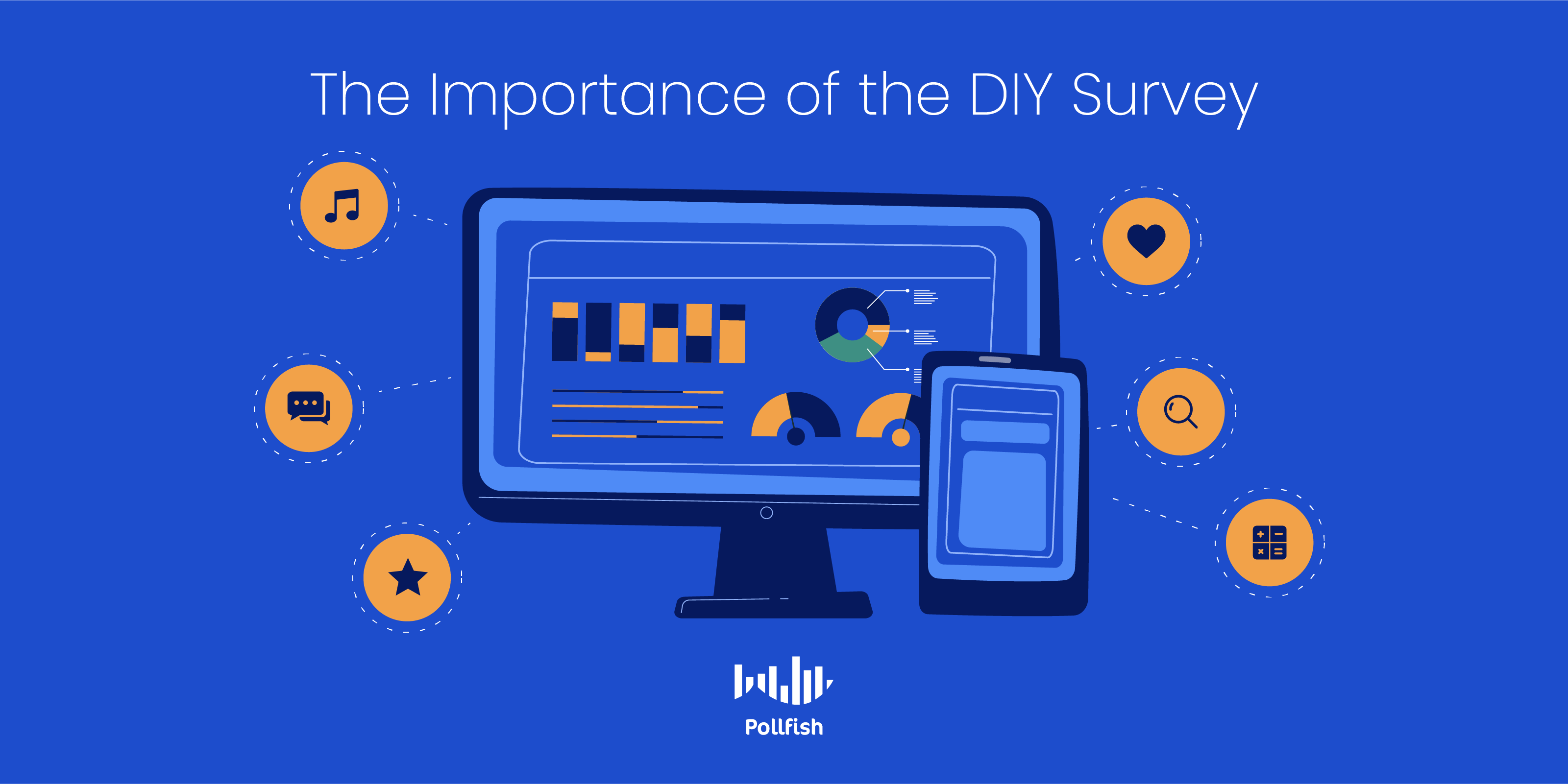Diving Into the DIY Survey and How It Can Aid Your Organization
 When it comes to primary market research and its chief method of survey research, the DIY survey reigns supreme. To some, this may appear to be subjective, but this kind of survey method sits at the forefront of market research innovation.
When it comes to primary market research and its chief method of survey research, the DIY survey reigns supreme. To some, this may appear to be subjective, but this kind of survey method sits at the forefront of market research innovation.
A DIY survey offers virtually everything that you would expect from the data you extract via syndicated research. The main difference is its benefit of saved time, as this method collects all that is necessary for completion, requiring very little from the researcher.
Depending on the online survey platform hosting this survey, it also applies artificial intelligence and machine learning to disqualify dodgy answers.
Given that market research is a gateway to customer data, a customer data platform is now more important than ever, as 60% of customers have higher expectations than they did before COVID-19. Crafting a DIY survey brings customer insights directly to businesses, so that they can fulfill all of their customers’ needs.
This article explores the DIY surveys, their importance, uses and how to conduct an insights-driven DIY survey study.
Understanding the DIY Survey
The DIY survey is a kind of survey that, as its name suggests, allows researchers to take a do-it-yourself approach to the survey. As such, a DIY survey is a tool that grants researchers ultimate control over their survey.
A DIY survey platform offers multiple capabilities that facilitate the survey creation process. With such a survey approach, the end-user is at the helm of the study; as such, you get to dictate its overall theme, objectives, target market, design, quotas and all else.
However, not all DIY survey platforms offer the same functionalities; as such, some will have more limitations than others, some will have completely different survey sampling methods and these platforms will also offer different levels of reach.
For example, such a platform may offer survey deployment to a wide network of websites and apps, but not offer the RDE (random device engagement sampling method), which captures respondents in their natural digital habitats.
The DIY survey provides agile market research, as researchers can quickly iterate their surveys and test different concepts. Some platforms even provide in-survey A/B testing so that you can test ads and virtually anything else.
The Importance of a DIY Survey
The DIY survey approach allows you to create effective surveys for market research campaigns. Given that surveys are the heart of a market research campaign, it is important to correctly carry them out correctly.
This includes properly creating, deploying and analyzing survey data. The proper DIY survey facilitates all of these aspects.
A DIY survey allows start-ups, early entrants and long-established businesses to evaluate their product, service, experience and brand without spending a large sum of money. They can apply a DIY survey to just about any market research campaign, to support marketing, advertising, branding and other campaign types.
 For example, researchers can carry out brand tracking campaigns with the brand tracking survey. Using a brand research platform, they can keep continuous tabs on their business and how it’s perceived.
For example, researchers can carry out brand tracking campaigns with the brand tracking survey. Using a brand research platform, they can keep continuous tabs on their business and how it’s perceived.
A DIY survey is especially important, as it offers three major capabilities: survey design, deployment and sampling and analysis. The following explains the importance of a DIY survey in regards to each capability.
Survey Design:
A DIY survey puts you in control of the survey design. A strong online survey platform allows you to make your own survey in just three steps. As such, it won’t take days or even hours to put together a well-designed survey.
This kind of survey allows you to add all the main types of survey questions. As such, you aren’t bound by one question type or format. Questions can be set up as scales, scores and even icons.
You can also create survey paths based on respondent answers via advanced skip logic, which routes respondents to different follow-up questions, based on how they answered a question. This way, respondents are only presented with relevant questions, the kinds that allow you to probe further on a subject.
When it comes to designing a DIY survey, you are also in control of the target market sample. A DIY survey platform should allow you to target your respondents as granularly as possible, setting qualifications on various categories, such as demographics, behaviors, psychographics, education and many more categories.
It should allow you to target your respondents via screening questions, which enables you to qualify or disqualify a respondent, based on their answers to questions. In these ways, you get to target your audience as precisely as possible.
Survey Deployment and Sampling
A DIY survey makes it easy to distribute your survey to the masses. As such, you don’t need to wait for third-party results from a research firm. Instead, you’ll see your results arriving in real-time. A strong survey platform will automatically send your survey to the most highly trafficked websites and apps, exposing your survey to the masses and ensuring that someone from your target population sees it and partakes in it.
When it comes to sampling, an effective DIY survey will apply the aforementioned RDE (random device engagement) method, in which the survey platform gains respondents by extracting the responses of random people from their organic digital environment, as opposed to pre-recruiting them.
This weeds out the possibility of societal pressure to answer in a certain way, along with survey bias. This sampling method grants respondents complete anonymity. As such, they are more inclined to answer truthfully.
Survey Analysis
A powerful DIY survey grants you the ease of analyzing your raw survey data. In the correct platform, there ought to be several displays of your survey results. This includes results configured as questions and answers, charts, graphs, crosstabs and spreadsheets.
It should also include SaaS integrations for you to easily integrate your survey dashboard with other SaaS providers, such as BigQuery. This gives you a comprehensive survey research experience, as you can refer to more than one platform to analyze your results. By integrating them, it makes cross-referencing two sets of data that much more feasible.
A DIY survey platform should offer a robust filtering data capability, so that you do not merely have filtering options in the screening section of the survey, but in the post-survey results as well. You can filter this data in a variety of ways, which includes doing so based on respondent location, demographics, psychographics or answer type.
This grants you easy access to a variety of statistics, allowing you to easily maneuver with all the data you’ll need to power your study.
The Pros and Cons of a DIY Survey
A DIY survey is the foremost tool of modern-day market research, granting you all the insights you’ll need without relying on a third party. If the above section didn’t fully convince you of the importance of the DIY survey, the following list of pros will support its prowess.
However, as with anything, this type of survey has a few disadvantages, which you should know about before you implement it for your next market research endeavor. The following lists provide highlights of the pros and cons of the DIY survey:
The Pros
- Ensures complete control over a survey research campaign.
- The main and usually only tool you’ll need to carry out primary market research.
- Provides quick results, protecting researchers from waiting weeks for the survey to be complete.
- Takes as little as a few days or hours to complete.
- Gives you access to affordable research
- Allows you to easily gain consumer, partner (via B2B surveys) and employee feedback.
- Easy to set up and user-friendly.
- Avoids having to rely on third-party results, which may be altered.
- Enables you to set quotas, so you receive the exact amount of answers as you please, from specific groups of people.
- Allows you to add multiple audiences in just one survey.
- Grants you access across all geographies, which makes it possible to conduct global market research.
- Supports data democratization so that all team members have easy access to data and all can contribute ideas on using it for critical business decisions.
The Cons
- Since you’re fully in charge, you’re required to work on all aspects of the survey campaign and keep track of all its details.
- To ensure an inaccurate campaign, you’ll need to measure and keep several variables to a minimum, such as the margin of error and the sampling error.
- You’ll need to be aware of and attempt to reduce various kinds of survey bias.
- You’ll need to be wary of the different kinds of survey respondents; some of them break rules and provide faulty information, such as flatlining or gibberish answers.
- You’ll need to contend with survey attrition; as such, you’ll need to optimize your surveys.
How to Conduct A DIY Survey

To conduct a successful DIY survey, you’ll need to gather all of your requirements, so you’ll know the best appropriate type of survey to use, along with the best survey method.
The following explains how to conduct a DIY survey:
- Determine what you need to study; consider all the things that matter to your business, such as matters that you have few answers to or would like more clarity on.
- If you have already conducted exploratory or explanatory research, consider other related factors or issues that you’d like to study.
- When you find a topic of study, tie it to a larger purpose or campaign, such as advertising, optimizing the customer buying journey, etc.
- Consider conducting causal research on the matter, as this will find cause and effect relationships.
- If you perform it and identify cause and effect relationships, you may need to rework your intentions or original questions.
- Come up with several preliminary questions. An ideal starting point is to sift through the 6 main types of survey questions and to deliberate which will be most useful and relevant.
- When you’ve come up with 10-15 questions, consider organizing them into two or more surveys. Shorter surveys yield greater survey response rates.
- As you organize your questions, create the appropriate theme for each survey.
- Create a callout that briefly explains what the survey is for.
- Use a strong market research survey tool to create, launch and run your survey to the correct target market.
- Perform a survey data analysis, jot down key findings and share them with your team.
- Take action from your survey findings. You can also create more surveys to test your actions, such as via A/B testing.
Mastering All Business Endeavors
A DIY survey allows you to gain actionable insights quickly, moving the needle for all kinds of business campaigns. But in order to reap the most benefits out of your survey, you’ll need to opt for the strongest online survey platform.
After all, this platform dictates your DIY survey’s capabilities. When you’re deciding on the best market research tool for your business, use a mobile-first platform, as mobile dominates the digital space and you ideally need one with the best mobile experience.
The platform should also offer artificial intelligence and machine learning to remove low-quality data, offer a broad range of survey and question types, provide an estimated survey completion time, offer various viewing options of post-survey data, disqualify low-quality data (such as the aforementioned gibberish answers and flatlining) and more.
Most importantly, it should allow you to survey anyone. We suggest a platform with a reach to millions of consumers, along with one that offers the Distribution Link feature, so that you can not only deploy your survey to random respondents, but to specific people via email, social media, etc.
When you use a DIY market research tool with all of these capabilities, you’ll be getting the most out of your DIY survey. As such, the cons of this survey will be easy to overcome.
Pollfish Marketing Team
Ready to Try Pollfish?
Create your survey with AI, target high-quality respondents starting at $0.95 per complete, and start getting results in just minutes in real-time. From running a simple product concept survey to managing a constant stream of trackers for dozens of clients in dozens of countries, we’ve got you.
